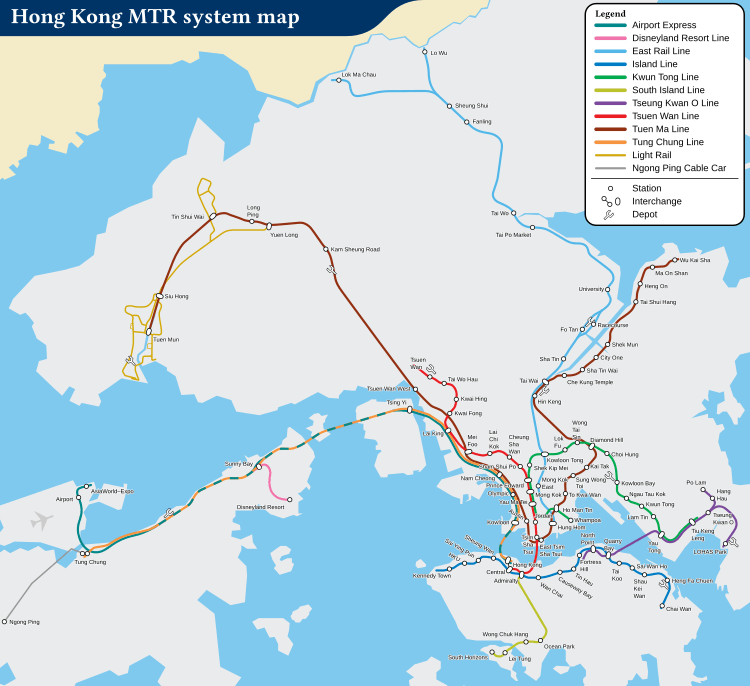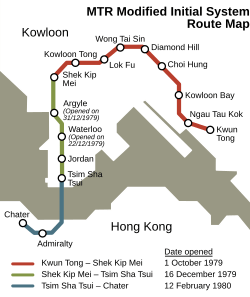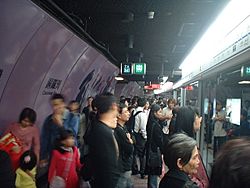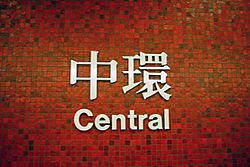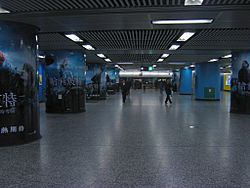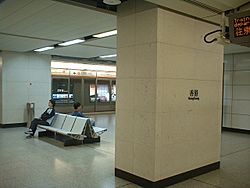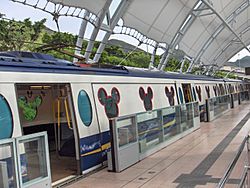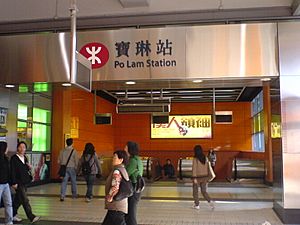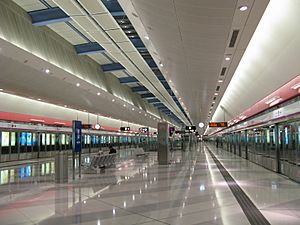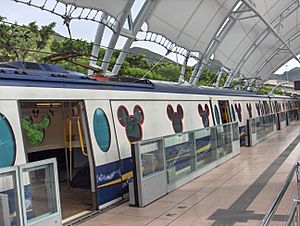MTR facts for kids
The Mass Transit Railway or MTR is Hong Kong's main train system. It's like a big underground and overground railway network. The MTR first opened in 1979 and now has 150 stations! It's built and run by the MTR Corporation Limited. The MTR is a very popular way to travel in Hong Kong. About 2.46 million people ride it every day.
Contents
Building the MTR
Hong Kong's growing economy caused many traffic problems. So, the Hong Kong government studied these issues. The first MTR line opened in 1979. People in Hong Kong quickly loved the MTR. Because of this, more lines were built to cover more areas. People still discuss how and where to expand the MTR network next.
MTR Network Lines
The MTR has many different lines, each with its own color. Here's a look at them:
| Line and color | Opened | Last Update | Start and End Stations | Stations | Travel Time (mins) | Depot | Track Width | Power | ||
|---|---|---|---|---|---|---|---|---|---|---|
| Kwun Tong Line | 1979 | 2002 | Yau Ma Tei | Tiu Keng Leng | 15 | 27 | Kowloon Bay Depot | 1432 mm | DC 1500 V | |
| Tsuen Wan Line | 1982 | N/A | Central | Tsuen Wan | 16 | 30 | Tsuen Wan Depot | |||
| Island Line | 1985 | 2014 | Kennedy Town | Chai Wan | 16 | 31 | Chai Wan Depot | |||
| Tung Chung Line | 1998 | 2005 | Hong Kong | Tung Chung | 8 | 28 | Siu Ho Wan Depot | |||
| Airport Express | 1998 | 2005 | AsiaWorld-Expo | 5 | 28 | |||||
| Disneyland Resort Line | 2005 | N/A | Sunny Bay | Disneyland Resort | 2 | 4 | ||||
| Tseung Kwan O Line | 2002 | 2009 | North Point | Po Lam / LOHAS Park |
8 | 15 | Tseung Kwan O Depot | |||
| East Rail Line | 1910 | 2007 | Hung Hom | Lo Wu / Lok Ma Chau |
14 | 40 / 43 | Ho Tung Lau Depot | 1435 mm | AC 25000 V | |
| West Rail Line | 2003 | 2009 | Hung Hom | Tuen Mun | 12 | 37 | Pat Heung Depot | |||
| Ma On Shan Line | 2004 | N/A | Tai Wai | Wu Kai Sha | 9 | 16 | Tai Wai Depot | |||
| Light Rail (12 routes) | 1988 | 2003 | Varies | Varies | 68 | Varies | Tuen Mun Depot | DC 750 V | ||
History of the MTR
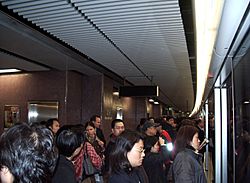
Early Ideas for the MTR
In the 1960s, the Hong Kong government realized they needed better transport. This was because Hong Kong's economy was growing fast, causing more road traffic. British transport experts studied the problem. In 1967, they suggested building an underground railway system.
In 1970, a new plan for four underground lines was made. These were the Kwun Tong Line, Tsuen Wan Line, Island Line, and East Kowloon Line. The lines that were actually built were a bit different from these first ideas.
In 1972, the Hong Kong government approved building the "Initial System." This was a 20-kilometer system, similar to today's Kwun Tong Line. In 1974, a Japanese company planned to build it but pulled out due to the oil crisis.
First Lines: Kwun Tong and Tsuen Wan
In 1975, a new government group, the Mass Transport Provisional Authority, took over. They made the system a bit smaller, calling it the "Modified Initial System." Instead of one big contract, they split it into many smaller ones.
The Hong Kong Mass Transit Railway Corporation (MTRC) was then created. Construction started in November 1975. The first part opened on September 30, 1979. Trains ran from Shek Kip Mei to Kwun Tong. The route to Tsim Sha Tsui opened in December that year.
In 1980, the Kwun Tong Line crossed Victoria Harbour to Central station. Trains were made longer, with six cars, to carry more people.
The government approved building the Tsuen Wan Line in 1977. Work began in November 1978. This line added 10.5 kilometers to the MTR system. It ran from Prince Edward to Tsuen Wan. The line opened on May 10, 1982, costing HK$4.1 billion.
When the Tsuen Wan Line opened, part of the Kwun Tong Line was changed. The section from Central to Mong Kok became part of the Tsuen Wan Line. This made Yau Ma Tei the end of the Kwun Tong Line. Mong Kok and Prince Edward stations became places where you could change lines. This change was made because experts thought the Tsuen Wan Line would be busier. This prediction was correct.
Island Line and Harbour Crossing
The government approved the Island Line in December 1980. Construction started in October 1981. On May 31, 1985, the Island Line opened. It ran between Admiralty and Chai Wan stations. Admiralty and Central stations became places to change to the Tsuen Wan Line. All trains were made even longer, with eight cars.
On May 23, 1986, the line reached Sheung Wan station. This station was delayed because government offices on top of it had to be moved first.
In 1984, the government approved building the Eastern Harbour Crossing. This was a tunnel for both cars and MTR trains. The Kwun Tong Line was extended across the harbor to Quarry Bay. Quarry Bay became a station where you could change between the Kwun Tong Line and the Island Line. This extension opened on August 5, 1989. A new station, Lam Tin, opened on October 1, 1989.
Airport Express and Tung Chung Line
In October 1989, it was decided to build a new international airport. It would be at Chek Lap Kok on Lantau Island. The government asked the MTR to build a train line to this new airport. This line was first called the Lantau Airport Railway. But construction didn't start until 1994. This was because the Chinese and British governments needed to agree on money and land.
The new line was important for the new Hong Kong International Airport. The airport wouldn't work well without good public transport. The MTR also helped pay for construction. In return, they were allowed to build large housing and shopping areas near the new stations.
The Lantau Airport Railway became two MTR lines: the Tung Chung Line and the Airport Express. The Tung Chung Line opened on June 21, 1998. The Airport Express opened on July 6, 1998, the same day as the new airport.
The Airport Express is the second most popular way to get to the Hong Kong International Airport. In 2005, 22% of travelers used it.
Tseung Kwan O Line
To help with crowding at Quarry Bay, the Kwun Tong Line was extended. It went from Quarry Bay to North Point through a 4.2-kilometer tunnel. This project started in September 1997 and finished in September 2001. It cost HK$3.0 billion (about US$385 million). This new section made it easier to change trains. Passengers could simply walk across the platform to switch lines.
Building the Tseung Kwan O Line was approved in August 1998. It was built to serve new housing areas. Construction began in April 1999. The line officially opened in 2002. It took over the train tracks in the Eastern Harbour Tunnel from the Kwun Tong Line. It ran from Po Lam to North Point. When it opened, the Kwun Tong Line was rerouted to Tiu Keng Leng on the new line. The Hong Kong Government and private companies helped pay for this line. This opened up new areas for building homes and shops.
West Rail Line
While the Tung Chung Line was being built, plans for a railway in the northwestern New Territories began. Space was saved for a new station and two extra tracks between Olympic and Lai King. This would allow the Airport Express to pass without stopping. This project was called the West Rail Line Interface Works.
The work was done in stages. Tung Chung Line trains started using the new track in May 2003. The Mei Foo Station interchange and Nam Cheong Station opened in December 2003. This was when the West Rail Line started. The Kowloon Southern Link extension opened on August 16, 2009. This extended the West Rail Line to Hung Hom Station. Hung Hom is a station where you can change to the East Rail Line.
Easy Interchange Stations
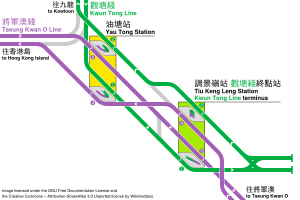
The MTR network has a clever way to help passengers change lines. At some stations, like between the Island, Tsuen Wan, Kwun Tong, and Tseung Kwan O lines, you can do a "cross-platform interchange." This means you get off a train on one side of the platform and get on another train on the other side.
For example, if you're on the Kwun Tong Line going to Tiu Keng Leng, you can get off at Yau Tong. Then, you just walk across the platform to catch a Tseung Kwan O Line train going to North Point. If you stay on the train to Tiu Keng Leng, you can change to the Tseung Kwan O Line going to Po Lam or LOHAS Park. This makes changing trains very easy and fast.
This special design is not available at all interchange stations. For example, at Kowloon Tong or Central, you might need to go to a different level. This easy system works best when two lines share two stations in a row for changing trains.
Ma On Shan Line
The Ma On Shan Line was built by KCR to serve the Ma On Shan and City One areas. MTR operates it. Most of this line runs on elevated tracks in the middle of roads. The stations are right next to big buildings. The trains on this line run on the right side, not the left. This is different from other MTR lines. It's done so passengers can easily change from the Ma On Shan Line to the East Rail Line towards Hung Hom. Many passengers use this line to get to Tai Wai and then switch to the East Rail Line.
Disneyland Extension
The Disneyland Resort Line takes visitors to the Hong Kong Disneyland Resort. The resort opened on September 12, 2005. Service to Sunny Bay station on the Tung Chung Line started in 2005. The new Disneyland Resort Line and station opened on August 1, 2005. It's a 3.5-kilometer single-track railway between Sunny Bay and Disneyland Resort stations. The Disneyland Resort station looks like it's part of the theme park. The trains run automatically without a driver. The train cars were changed to look fun and adventurous for the short 3.5-minute ride.
Airport Express Expansion
The new AsiaWorld-Expo Station is an extension of the Airport Express. It serves the new international exhibition center, AsiaWorld-Expo, at Hong Kong International Airport. The station opened on December 20, 2005, with the exhibition center. To handle more passengers, Airport Express trains were made longer, from seven to eight cars. More trains are also used on the Tung Chung Line during big events.
MTR Company Changes
On October 5, 2000, the company that runs the MTR, MTR Corporation Limited (MTRCL), became a private company. This meant the Hong Kong government sold some of its shares. Before this, the government owned the MTRC completely. The company now has many shareholders. In June 2001, MTRCL was added to the Hang Seng Index, which tracks major companies in Hong Kong.
MTRCL often builds properties like housing estates or shopping centers next to its stations. This helps the company earn more money. For example, Tsing Yi station is built next to the Maritime Square shopping center and under the Tierra Verde housing estate.
On April 11, 2006, MTRCL and the Hong Kong government agreed to combine the MTR and KCR railway networks. This happened despite some staff not agreeing. On December 2, 2007, MTRCL took over running the KCR network for 50 years. This combined the fare systems of both networks. MTRCL's Chinese name changed to "Hong Kong Railway Limited Company," but its English name stayed the same. After the merger, the MTR network included the East Rail Line, West Rail Line, Ma On Shan Line, Light Rail, and trains to Guangzhou.
On September 28, 2008, the fare zones for all former KCR lines were combined. Now, passengers can travel on these networks with just one ticket. Student discounts on Octopus Cards were also introduced.
Safety on the MTR
The MTR works hard to make sure it's a safe system. You'll often see posters about safety, like how to use escalators. Announcements are also made regularly to remind passengers to be safe.
New rules have been made to stop dangerous actions on the MTR. For example, you can't bring flammable items on the train. You also can't rush into trains when the doors are closing. If you break these rules, you could get a fine or even go to jail. Metallic balloons are also not allowed. This is because they caused problems with the overhead power lines in the past.
Police officers patrol trains and stations. Some stations also have police posts. The Hong Kong Police Force has a special Railway District for the MTR. Closed-circuit television cameras are in all stations.
The Tung Chung Line, Airport Express, and Tseung Kwan O Line (except Quarry Bay station) have platform screen doors (PSDs). These doors prevent people from falling onto the tracks. They also help save energy by keeping the station air-conditioning separate from the tunnels. Automatic platform gates (APGs) are at Sunny Bay and Disneyland Resort stations. These are half the height of PSDs and also prevent people from falling onto the tracks.
In 2000, the MTR Corporation started adding platform screen doors to 30 older underground stations. This included the Kwun Tong Line, Tsuen Wan Line, and Island Line. This project finished in October 2005. The MTR was the first railway in the world to add these doors to an already running system. Passengers paid a small fee (HK$0.10 per trip) to help fund this HK$2 billion project.
Station Facilities and Services
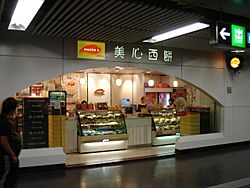
MTR stations are built to be very strong and easy to use. This is because so many people use them every day. The elevators and escalators are very tough.
The MTR system is very friendly for people with disabilities. Trains have special spaces for wheelchairs. Stations have special floor tiles to guide blind people safely. There are also extra wide entry and exit gates for wheelchairs.
Unlike many other train systems, most MTR stations don't have public toilets. Only stations on the Airport Express and Disneyland Resort Line have them.
Easy Interchange Stations
The MTR network is special because of how its interchange stations are set up. At many stations where lines meet, like the Island, Tsuen Wan, Kwun Tong, and Tseung Kwan O lines, you can change trains very easily. You just get off one train and walk across the platform to get on another.
For example, if you're on the Kwun Tong Line going towards Tiu Keng Leng, you can get off at Yau Tong. Then, you can walk across the platform to catch a Tseung Kwan O Line train going towards North Point. If you stay on the train and go to Tiu Keng Leng, you can change to the Tseung Kwan O Line going towards Po Lam.
This makes changing trains much more convenient. It also helps spread out the number of people at each station. The trains tell you the best place to change lines with messages and announcements.
Mobile Phone Coverage
You can use your mobile phone throughout the MTR system, even in tunnels! There's full mobile phone network coverage (GSM, CDMA, TDMA). So, passengers can stay connected underground.
Most stations and tunnels also have full 3G network coverage. This means you can make video calls and watch high-speed videos on your phone. It works whether the train is above ground or underground.
Shops and Other Services
In the past, MTR stations mostly had Hang Seng Bank branches and Maxim's Cakes shops. But since the MTR became a private company, many more shops have opened. Some stations are now like small shopping centers. Services at most stations include:
- Hang Seng Bank branches and ATMs
- Bank of China ATMs
- 7-Eleven or Circle K convenience stores
You can also find dentists, medical clinics, drycleaners, and florists along the Tseung Kwan O Line. Standard services include payphones, vending machines (for Coca-Cola), and photo booths.
Free Magazines and Newspapers
Recruit was the first free magazine given out in MTR stations, starting in 1992. Later, Jiu Jik (招職), a recruitment magazine, took its place. It's given out on Tuesdays and Fridays.
Metropolis Daily (都市日報) is a free newspaper. It's given out in MTR stations from Monday to Friday (except public holidays). In 2005, another free weekend newspaper, Express Post (快線周報), started.
Metropop (都市流行) is a weekly magazine about culture and city trends. It started being given out in MTR stations on Thursdays in April 2006.
Extra Services for Airport Express
The Airport Express offers special services for travelers. Toilets and check-in facilities are available at every station on the line. There's also a free Airport Express shuttle bus service. It takes travelers from stations to their hotels. Passengers can even check in for their flights at the station. This makes travel more convenient and saves time.
Fares and Tickets
As of January 2005, there are two types of fares on the MTR: Adult and concessionary.
- Children under 12
- Senior citizens (65 or older)
- Full-time Hong Kong students (12-25 years old)
These groups can get the concessionary (discounted) rate. Children under 3 travel for free.
The price of a ticket depends on how far you travel. The MTR uses "fare zones." All stations in a zone cost the same price from your starting point. The price increases with distance, especially if you cross the harbor. Adult fares range from HK$3.80 to $26.00. Discounted fares are usually half the adult fare, from HK$2.40 to $13.00. Fares for the Airport Express Line are much higher.
Using the MTR is very affordable. For example, a taxi from Tsing Yi to Causeway Bay costs about HK$200. The same trip by MTR costs HK$11.80 for adults and HK$5.40 for children and seniors. You can buy a one-way ticket or use an Octopus card. The Octopus card is a special card you can tap to pay.
Octopus Cards
The Octopus card is a rechargeable card used for electronic payments in Hong Kong. It started in September 1997 for the MTR and KCR. Now, it's the most used electronic payment system in Hong Kong. Many shops also accept it.
The Octopus card uses radio frequency identification (RFID) technology. You just hold the card near the reader. You don't even need to take it out of your wallet or bag! This payment system has become very popular. Many cities like Singapore, London, and Taipei have copied the idea. They have their own versions of smart cards.
MTR fares are a bit cheaper when you use an Octopus card compared to single journey tickets. For example, in 2005, a trip from Admiralty to Tsim Sha Tsui cost HK$7.9 with an Octopus card, but HK$9.0 for a single ticket.
Tourist Passes
There are two types of tourist passes:
- One allows unlimited rides for one day (HK$50).
- The other allows three days of unlimited MTR rides. It also includes HK$20 stored value, a refundable HK$50 deposit, and a choice of a single (HK$220) or return (HK$300) trip on the Airport Express.
Tourists need to show proof, like a passport, when buying the pass. They might also need to show it to a ticket inspector.
Other Fares
Single journey tickets use a magnetic card system. These tickets are for one trip between specific stations. There are no return tickets, except on the Airport Express.
Airport Express fares are very different from regular MTR fares. Besides single tickets, you can buy same-day return tickets (same price as a single) and one-month return tickets.
A one-day pass for unlimited travel to/from Hong Kong Disneyland costs HK$50. You can buy this pass at any MTR Customer Service Centre or Airport Express Customer Service Centre.
MTR Trains
The MTR uses four types of trains. All trains are electric and use overhead power lines. They have special systems for automatic control and protection. Most trains are designed to carry many passengers. They have seats along the sides, extra fans, and five doors on each side of every car.
The Tung Chung Line and the Airport Express use special trains. They started with 7 cars but now have 8 cars. These trains were built by Adtranz (now Bombardier) and Construcciones y Auxiliar de Ferrocarriles.
Other lines use "M-Train" and "K-Stock" trains. The "M-Stock" (or "M-Train") trains are the oldest. They were built by Metro Cammell (now Alstom) and updated by United Goninan. M-Trains are the only ones with sliding doors; others have plug-doors. The "K-Stock" trains were built by Mitsubishi Heavy Industries and ROTEM.
The Disneyland Resort Line uses driverless M-Trains. Their look was changed to fit the Disney theme. Windows and handrails are shaped like Mickey Mouse's head. Bronze Disney characters decorate the inside of the cars.
Here are the types of trains used on each line:
- Tsuen Wan Line: MTR Metro Cammell EMU (DC)
- Kwun Tong Line: MTR Metro Cammell EMU (DC), MTR CNR Changchun EMU
- Tseung Kwan O Line: MTR Metro Cammell EMU (DC), MTR Rotem EMU
- Island Line: MTR Metro Cammell EMU (DC)
- Airport Express: MTR Adtranz-CAF EMU
- Tung Chung Line: MTR Adtranz-CAF EMU, MTR Rotem EMU
- East Rail Line: MTR Metro Cammell EMU (AC), MTR SP1900 EMU
- West Rail Line: MTR SP1900 EMU
- Ma On Shan Line: MTR SP1950 EMU
- Light Rail: Varies
Art in the MTR
The "Art in MTR" program started in 1998. Its goal is to give MTR passengers "more time for art." Since then, MTR stations have hosted live performances, art shows, and displays of artwork. These artworks are by famous artists, new artists, students, and children. MTR Corporation Limited even includes art in the design of new stations and when updating old ones.
Art is shown in many ways in the MTR. There's "arttube" (an art subway), open art galleries, community art galleries, and moving art displays. By adding art to the railway, the MTR makes journeys more pleasant and enjoyable for passengers. It also helps promote local art and gives people a feeling of home at the stations.
The Future of MTR
MTR Corporation Limited has suggested several new projects to the Hong Kong Government. Some are already being built. The network will grow a lot when MTR Corporation Limited joins with the government-owned Kowloon-Canton Railway Corporation (KCRC). They signed an agreement on April 11, 2006. This gives MTR Corporation control of the KCR network for 50 years. The new Sha Tin to Central Link, which was first planned for KCRC, will now also be run by MTR Corporation Limited. This line will go from Tai Wai Station to Central.
There are also plans to improve parts of the current MTR system. Airport Station on the Airport Express will get a new platform. This will serve passengers flying out of Hong Kong International Airport's Skyplaza. New subway links to stations are also being built. It's been suggested to extend the Tseung Kwan O Line with a branch to Tseung Kwan O South. The Kwun Tong Line might also be extended to Whampoa Garden, connecting with the Sha Tin to Central Link.
The West Island Line and South Island Line was first suggested in January 2003. It was finally approved on June 30, 2005. This project includes the West Island Line, which extends the Island Line to Kennedy Town. It also includes the South Island Line (East section) from Admiralty to Ap Lei Chau. The South Island Line (West section) will connect these two lines. This project is being discussed, and the whole extended line should be finished by 2012.
Images for kids
See also
 In Spanish: Metro de Hong Kong para niños
In Spanish: Metro de Hong Kong para niños


